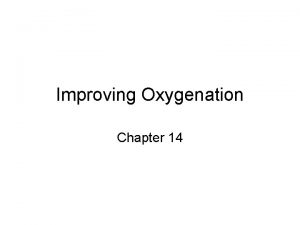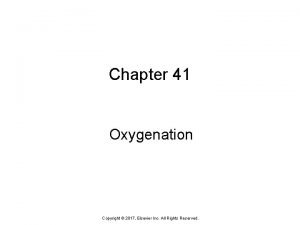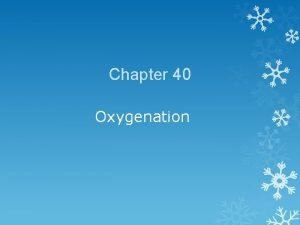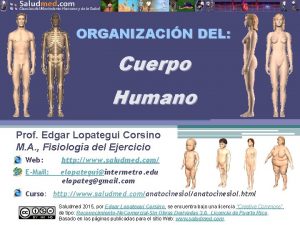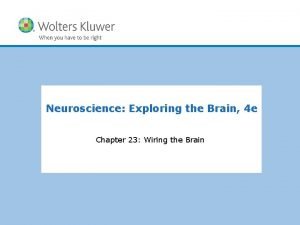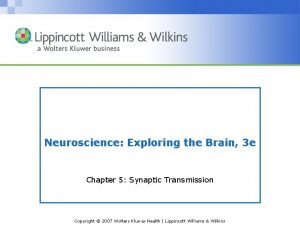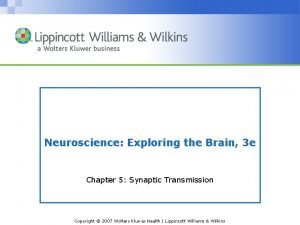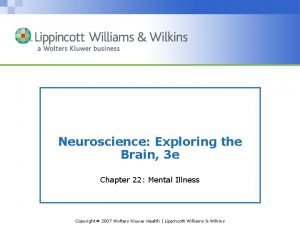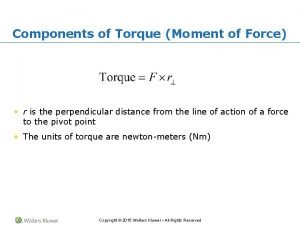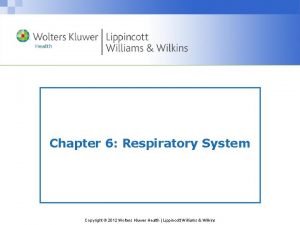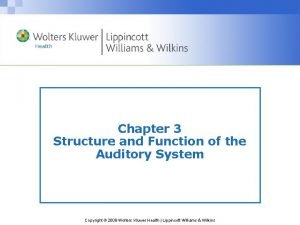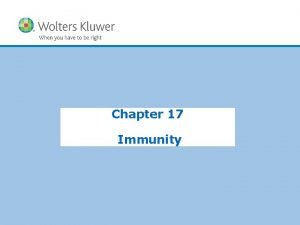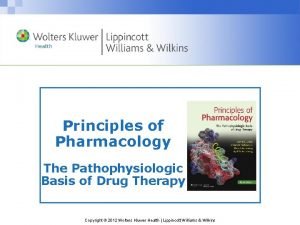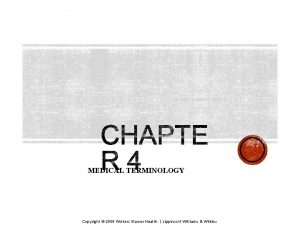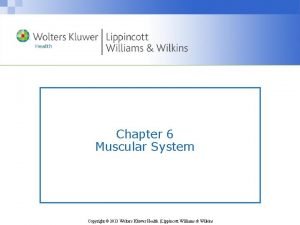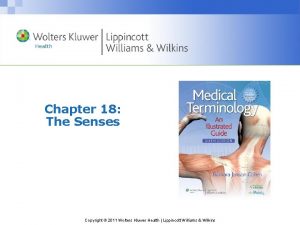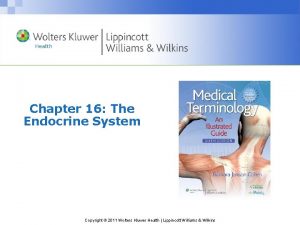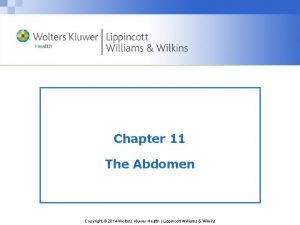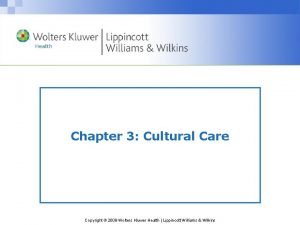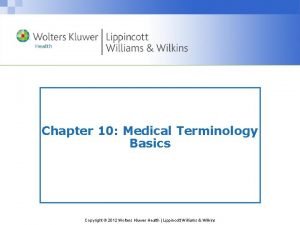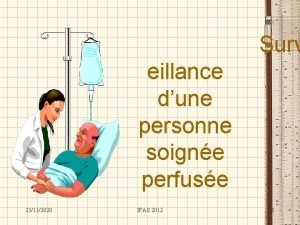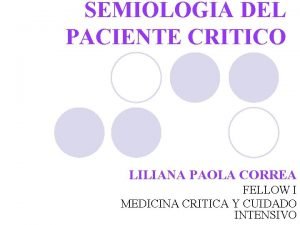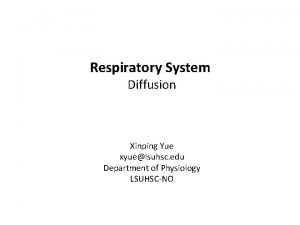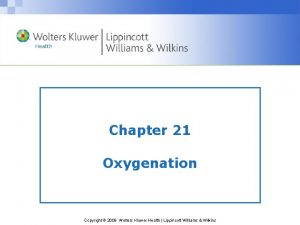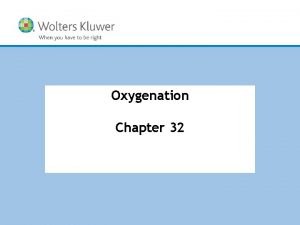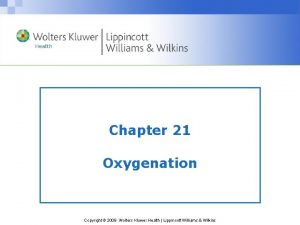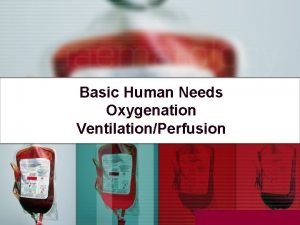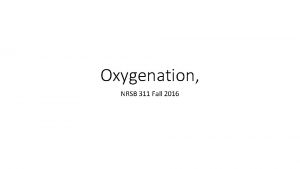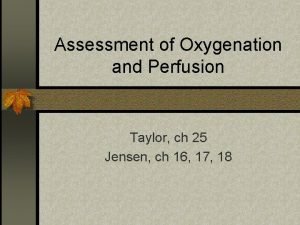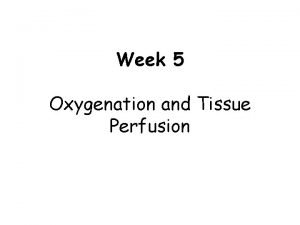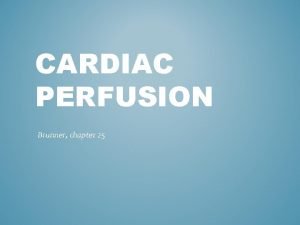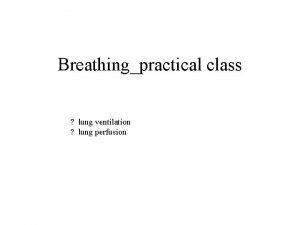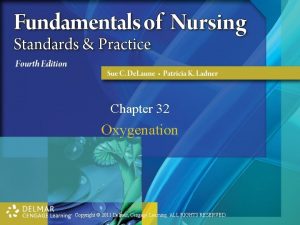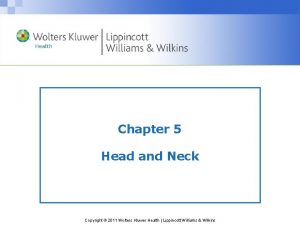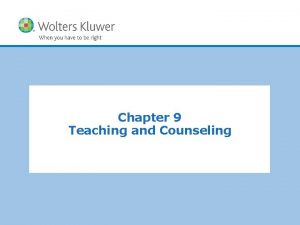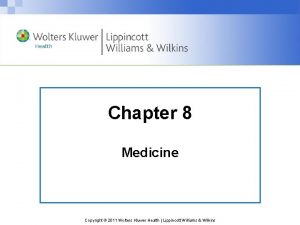Chapter 38 Oxygenation and Perfusion Copyright 2011 Wolters






























- Slides: 30

Chapter 38 Oxygenation and Perfusion Copyright © 2011 Wolters Kluwer Health | Lippincott Williams & Wilkins

Oxygenation and Perfusion depend on…. . • The condition of the airway system from nose to alveoli • Properly functioning alveolar system in lungs to facilitate gas exchange • Properly functioning cardiovascular and hematologic systems that carry nutrients and wastes to and from body cells Copyright © 2015 Wolters Kluwer • All Rights Reserved

Function of the Airway • Warm, filter, humidify inspired air • Movement of air • Clearance of mucus by cilia • Production of pulmonary surfactant Copyright © 2015 Wolters Kluwer • All Rights Reserved

Anatomy of the Lungs • Main organs of respiration • Extend from the base of the diaphragm to the apex above the first rib • The right lung has three lobes; the left lung has two. • The lungs are composed of elastic tissue (alveoli, surfactant, pleura). Copyright © 2015 Wolters Kluwer • All Rights Reserved

The Organs of the Respiratory Tract Copyright © 2015 Wolters Kluwer • All Rights Reserved

Pulmonary Ventilation • Inspiration: the active phase of ventilation – Involves movement of muscles and the thorax to bring air into the lungs • Expiration: the passive phase of ventilation – Movement of air out of the lungs Copyright © 2015 Wolters Kluwer • All Rights Reserved

Process of Ventilation • Inspiration begins when the diaphragm contracts and descends, lengthening the thoracic cavity. • The external intercostal muscles contract, lifting the ribs upward and outward. • The sternum is pushed forward, enlarging the chest from front to back • The relaxation of these structures results in expiration. Copyright © 2015 Wolters Kluwer • All Rights Reserved

Gas Exchange (Respiration) • Refers to the intake of oxygen and release of carbon dioxide • Made possible by respiration and perfusion • Gas exchange occurs via diffusion at the alveolar level • Alveoli have a single layer membrane that allows the exchange of oxygen and carbon dioxide between the alveolar sacs and the capillaries Copyright © 2015 Wolters Kluwer • All Rights Reserved

Transport of Respiratory Gases • Oxygen is carried in the body via plasma and red blood cells. • Oxygen and carbon dioxide are carried by red blood cells in the form of oxyhemoglobin and carboxyhemoglobin. • Internal respiration occurs between the circulating blood and tissue cells in the body. This is called perfusion. Copyright © 2015 Wolters Kluwer • All Rights Reserved

Cardiovascular System • Vital for exchange of gases • Composed of the heart and the blood vessels • The heart is a cone shaped, muscular pump, divided into four hollow chambers: – Atria receive blood from the veins: superior and inferior vena cava (from body) and the left and right pulmonary veins (from lungs). – Ventricles force blood out of the heart through the arteries: aorta (to body) and the left and right pulmonary arteries (to lungs). Copyright © 2015 Wolters Kluwer • All Rights Reserved

Factors Affecting Cardiopulmonary Functioning and Oxygenation • Developmental considerations • Alterations in health • Medications • Lifestyle Copyright © 2015 Wolters Kluwer • All Rights Reserved

Developmental Considerations – Infants are nose-breathers – Children have shorter airways – Older adults have decreased elasticity in lungs and CV system and skeletal changes that can affect lung performance Copyright © 2015 Wolters Kluwer • All Rights Reserved

Alterations in Health Factors • Cardiac disease • Vessel disease • Blood clots • Pulmonary disease • Skeletal abnormalities • Diabetes • Deconditioning and bedridden • Swallowing difficulties • Depression • Trauma • Infections Copyright © 2015 Wolters Kluwer • All Rights Reserved

Alterations in Respiratory Function • Hypoxia: inadequate amount of oxygen available to the cells • Dyspnea: difficulty breathing • Hypoventilation: decreased rate or depth of air movement into the lungs Copyright © 2015 Wolters Kluwer • All Rights Reserved

Alterations in the Cardiovascular System • Dysrhythmia (irregularity) • Myocardial ischemia (meaning low oxygen and perfusion to the heart muscle) • Angina (pain from severe ischemia) • Myocardial infarction (death of tissue from prolonged ischemia) • Heart failure (damaged pump) Copyright © 2015 Wolters Kluwer • All Rights Reserved

Medication factors • Cardiac medications—can control irregularities, improve pump function, control pressures, treat or prevent pain • Anticoagulants and aspirin • Pulmonary medications—can open airways • Antibiotics—treat infection in the respiratory tract • Narcotics—can slow respiratory rate and decrease air exchange; however morphine is a vasodilator • Herbals Copyright © 2015 Wolters Kluwer • All Rights Reserved

Lifestyle Factors • Smoking • Sedentary • Illegal drugs • Dietary choices • Occupational exposure • Geographic location Copyright © 2015 Wolters Kluwer • All Rights Reserved

Nursing Interventions Promoting Adequate Respiratory Functioning • Effective breathing techniques • Effective coughing techniques • Suctioning the airway • Meeting oxygenation needs with medications • Smoking cessation • Avoiding environmental triggers Copyright © 2015 Wolters Kluwer • All Rights Reserved

Promoting Effective Breathing • Deep breathing • Using incentive spirometry (IS) • Pursed-lip breathing • Diaphragmatic breathing • Positioning Copyright © 2015 Wolters Kluwer • All Rights Reserved

Promoting Comfort • Positioning • Maintaining adequate fluid intake • Providing humidified air • Performing chest physiotherapy • Maintaining good nutrition • Pacing physical activities Copyright © 2015 Wolters Kluwer • All Rights Reserved

Medications • Cough suppressants • Expectorants • Lozenges • Bronchodilators • Antiinflammatories • Antibiotics • Oxygen Copyright © 2015 Wolters Kluwer • All Rights Reserved

Administering Inhaled Medications • Bronchodilators: open narrowed airways. Can be given po, IV, or by inhalation. • Nebulizers: disperse fine particles of liquid medication into the deeper passages of the respiratory tract (breathing treatment to dilate bronchioles) • Meter-dose inhalers: deliver a controlled dose of medication with each compression of the canister. Can be rescue or maintenance. • Dry powder inhalers: breath-activated delivery of medications Copyright © 2015 Wolters Kluwer • All Rights Reserved

Vehicles for Inhaled Meds Copyright © 2015 Wolters Kluwer • All Rights Reserved

Common Oxygen Delivery Systems • Nasal cannula— 1 -6 L/min. Can be humidified. • Venturi mask— 4 -10 L/min. O 2 mixes with room air, CO 2 is expelled. Has large tube attached. Allows for the most accurate delivery of whatever percentage the HCP wants. • Simple mask— 6 -8 L/min. O 2 mixes with room air, CO 2 is expelled • Partial rebreather mask— 8 -11 L/min. Has reservoir bag that traps exhaled CO 2. O 2 mixes with small amount of trapped expelled CO 2 on inspiration. • Nonrebreather mask— 12 L/min. Has reservoir bag that holds oxygen. Highest delivery of O 2. No mixing occurs because CO 2 is exhaled through vents. • Tent—used for peds. Plastic cover bed. Motor keeps air cool and humidified. Side vents allow nsg care. Can cause damp linens and clothing. Copyright © 2015 Wolters Kluwer • All Rights Reserved

Oxygen Masks Copyright © 2015 Wolters Kluwer • All Rights Reserved

Precautions for Oxygen Administration • Avoid open flames in the patient’s room. • Place “no smoking” signs in conspicuous places. • Check to see that electrical equipment in the room is in good working order. • Avoid wearing and using synthetic fabrics (builds up static electricity). • Avoid using oils in the area (oils ignite spontaneously in oxygen). Copyright © 2015 Wolters Kluwer • All Rights Reserved

Type of Artificial Airways • Oropharyngeal and nasopharyngeal airway-to maintain airway patency and facilitate suctioning • Endotracheal tube-to deliver oxygen and medications when patient is unconscious • Tracheostomy tube-inserted directly into the trachea from the outside to maintain airway patency when upper airway is obstructed Copyright © 2015 Wolters Kluwer • All Rights Reserved

Oropharngeal Airway Copyright © 2015 Wolters Kluwer • All Rights Reserved

Endotracheal Tube Copyright © 2015 Wolters Kluwer • All Rights Reserved

Two Types of Tracheostomy Sets: Cuffless and Cuffed (Cuffed allows ventilator) Copyright © 2015 Wolters Kluwer • All Rights Reserved
 Chapter 14 oxygenation test bank
Chapter 14 oxygenation test bank Chapter 41 oxygenation
Chapter 41 oxygenation What are the factors affecting oxygenation
What are the factors affecting oxygenation Wolters kluwer health
Wolters kluwer health Lippincott
Lippincott Wolters kluwer
Wolters kluwer Wolters kluwer
Wolters kluwer Shunting inhibition
Shunting inhibition Chemical synapse
Chemical synapse Wolters kluwer health
Wolters kluwer health Exercise physiology for health, fitness, and performance
Exercise physiology for health, fitness, and performance Wolters kluwer
Wolters kluwer Wolters kluwer health
Wolters kluwer health Wolters kluwer health
Wolters kluwer health Chapter 25 assessment of cardiovascular function
Chapter 25 assessment of cardiovascular function Wolters kluwer health
Wolters kluwer health Wolters kluwer
Wolters kluwer Virchow's triad
Virchow's triad Wolters kluwer pronunciation
Wolters kluwer pronunciation Wolters kluwer
Wolters kluwer Wolters kluwer
Wolters kluwer Wolters kluwer
Wolters kluwer Wolters kluwer
Wolters kluwer Wolters kluwer
Wolters kluwer Wolters kluwer ovid
Wolters kluwer ovid Wolters kluwer health lippincott williams & wilkins
Wolters kluwer health lippincott williams & wilkins Wolters kluwer culture
Wolters kluwer culture Wolters kluwer pronunciation
Wolters kluwer pronunciation Dilaflow
Dilaflow Insuficiencia cardiaca clasificacion stevenson
Insuficiencia cardiaca clasificacion stevenson Perfusion limited vs diffusion limited
Perfusion limited vs diffusion limited
